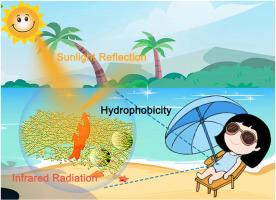Polyurethane-SiO2 tandem composite fibrous membrane for passive daytime radiative cooling
IF 6.3
2区 材料科学
Q2 ENERGY & FUELS
引用次数: 0
Abstract
Passive daytime radiative cooling (PDRC) is a promising energy-saving approach for intelligent textiles. However, the preparation process for most PDRC materials is complex and costly, and their surfaces are susceptible to contamination, leading to poor durability and thereby limiting their application fields. Herein, we report on a tandem passive radiation-cooled fibrous membrane consisting of elastic polymer and nanoparticles (NPs), which can achieve dual-functions of self-cleaning and passive radiative cooling. Specifically, a large number of SiO2 NPs on the surface of the composite fibrous membrane exhibit phonon-enhanced Fröhlich resonance, facilitating the emission of infrared radiation and imparting excellent radiation cooling performance to the fibrous membrane. This is reflected in the membrane's maximum effective reflectivity in the solar spectrum (88.29 %) and its infrared emissivity within the atmospheric window (94.9 %). On the other hand, the hydrophobic SiO2 particles, with their low surface energy, enhance the roughness of the fibrous membrane surface, resulting in a water contact angle of 145° for the fibrous membrane. Consequently, this tandem passively cooled fibrous membrane boasts a self-cleaning surface, which overcomes the fundamental challenges of radiative cooling and demonstrates sustainability under harsh conditions, further broadening its practical application areas.

用于日间被动辐射冷却的聚氨酯-二氧化硅串联复合纤维膜
被动式日间辐射冷却(PDRC)是一种很有前景的智能纺织品节能方法。然而,大多数 PDRC 材料的制备过程复杂且成本高昂,其表面易受污染,导致耐用性差,从而限制了其应用领域。在此,我们报告了一种由弹性聚合物和纳米粒子(NPs)组成的串联被动辐射冷却纤维膜,它可以实现自清洁和被动辐射冷却的双重功能。具体来说,复合纤维膜表面的大量 SiO2 NPs 表现出声子增强的弗洛里希共振,促进了红外辐射的发射,使纤维膜具有优异的辐射冷却性能。这体现在该膜在太阳光谱中的最大有效反射率(88.29%)和在大气窗口内的红外发射率(94.9%)。另一方面,疏水性二氧化硅颗粒的低表面能增强了纤维膜表面的粗糙度,使纤维膜的水接触角达到 145°。因此,这种串联被动冷却纤维膜具有自清洁表面,克服了辐射冷却的基本挑战,并在恶劣条件下表现出可持续性,进一步拓宽了其实际应用领域。
本文章由计算机程序翻译,如有差异,请以英文原文为准。
求助全文
约1分钟内获得全文
求助全文
来源期刊

Solar Energy Materials and Solar Cells
工程技术-材料科学:综合
CiteScore
12.60
自引率
11.60%
发文量
513
审稿时长
47 days
期刊介绍:
Solar Energy Materials & Solar Cells is intended as a vehicle for the dissemination of research results on materials science and technology related to photovoltaic, photothermal and photoelectrochemical solar energy conversion. Materials science is taken in the broadest possible sense and encompasses physics, chemistry, optics, materials fabrication and analysis for all types of materials.
 求助内容:
求助内容: 应助结果提醒方式:
应助结果提醒方式:


